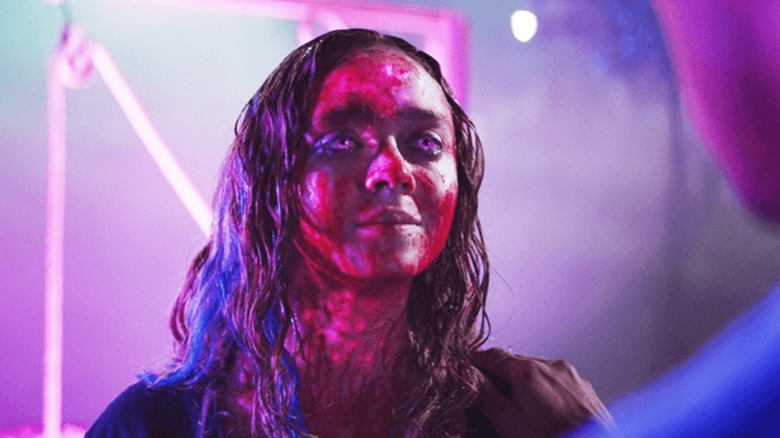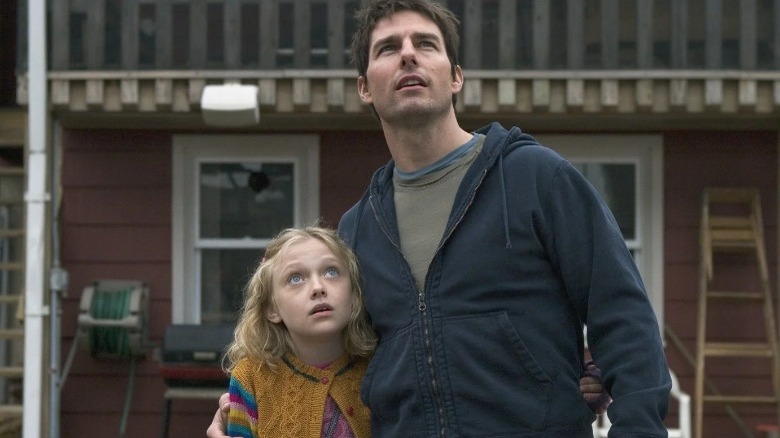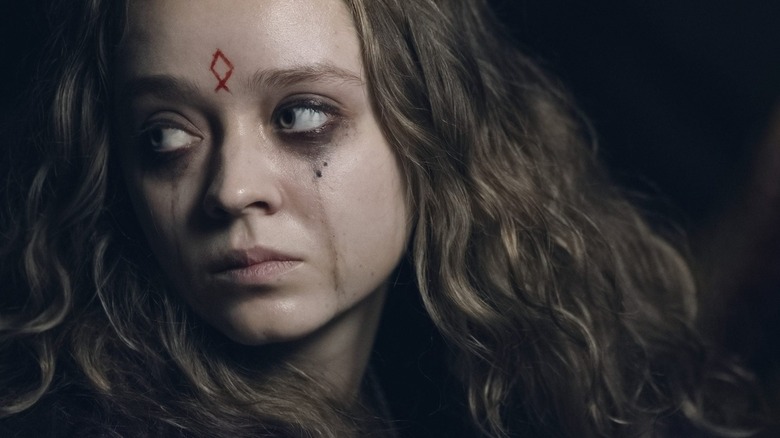Steven Spielberg's True Influence On Color Out Of Space
Richard Stanley's sci-fi Lovecraftian horror, "Color Out of Space," marked a comeback for the director after a span of 20 years. Best known for "Hardware" and "Dust Devils," which morphed into cult classics years after their release, Stanley largely stepped away from the industry in the '90s following his negative experiences as the director of "The Island of Dr. Moreau." His 2019 movie is an adaptation of H.P. Lovecraft's short story, "The Color Out of Space," and was intended to be the first film in a working trilogy of Lovecraft-based movies, with "The Dunwich Horror" being the next project.
"Color Out of Space" is a compelling entry in the cosmic horror genre, raising important questions about humanity's eventual extinction. The films follow patriarch Nathan Gardner (Nicolas Cage), who moves to a secluded farm with his family with the hopes of leading an idyllic life. While Nathan struggles with growing crops and rearing animals sustainably, things take a turn for the worse when a mysterious meteor crashes near their farm, exuding an eerie effect on the livestock and the Gardners in the process. While "Color Out of Space" cannot truly be classified as a cult classic (at least not at the moment), the film is a deft exploration of the horrors experienced by an isolated family unit, whose love for one another is not enough to overcome a dangerous, alien threat.
In interviews, Stanley has explained that the core themes in his film are actually influenced by the work of Steven Spielberg — specifically the trope of a close-knit family in American suburbia that succeeds in overcoming the most vicious of threats with the aid of collective resilience and action. The Gardner family in "Color Out of Space" subverts this trope in essential ways.
The subversion of Spielbergian notions of family
Speaking to The Hollywood Reporter, Stanley touched upon the idea of an American family unit fighting against all odds to keep each other safe, and how the fate of the Gardners point to the fact that such a utopian notion does not (and cannot) exist anymore:
"The notion that we may be looking extinction down the barrel — or at the end of a certain dream or the idea of the Spielberg-ian notion that one can actually safely raise your family and kids and alpacas in peace."
Spielberg's sci-fi films often feature the utopian ideal of living with one's family in peace (cut off from the world's horrors) interrupted by the threat from an outside source. Take "War of the Worlds," for instance, wherein the father Ray (Tom Cruise) fights tooth and nail to keep his children safe from swarms of extraterrestrials, emerging as the savior of the world in the process. Similarly, "E.T. the Extra-Terrestrial" focuses on the young protagonist Elliott overcoming unimaginable odds to rescue his new friend E.T. and reunite him with his family. While the family in "Color Out of Space" fits the Spielberg mold (at least initially), when Nathan tries his best to deal with his scenario, he is unable to save the world, or even his family, from the threats he's facing. This subverts Spielberg's idea of human survival by the virtue of love or sheer resilience alone.
Stanley also highlights through "Color" how being privileged enough to isolate oneself from the world's issues are useless in the face of a terror not from this world. The Gardeners' obsessive need to establish a self-sustained, utilitarian lifestyle fails, as it is not evolved enough to dissect what the Color wants or needs from a lifeform alien to it.
Being utterly out of touch
In another interview, Stanley states that "Color provides us with a snapshot of a Spielbergian, white-bread family unit at the point of extinction and not all the details it reveals are pleasant." This is true, as the Color is neither a benevolent being simply wishing to phone home like in "E.T.," nor is it a militaristic extraterrestrial race that can be thwarted with the help of guns and grenades, like in "War of the Worlds."
Instead, the interdimensional threat in "Color" is impossible to parse or understand, as it is a threat like no other — both beautiful and terrifying at once. Its otherworldly hue can both entrance and disintegrate those who come in touch with it. The Color "corrupts" life as we know it, pushing the Gardners to the edge of sanity, as they scramble to deal with this threat with whatever means necessary, as per the belief systems that guide them in their personal spheres.
For instance, Lavinia is the only Gardner who wishes to leave the farm, and we see her performing a ritual to save family from impending doom and facilitate her escape after the meteorite crashes. The spell obviously does not work against an interdimensional threat, and while she does not die, her wish to "escape" is fulfilled in a rather twisted way — she is inhabited by the Color and dragged off into space, where fresh new horrors await her. In Stanley's inversion of the Spielbergian trope, there is no true escape, and absolutely nothing, be it practical or magical, can help you evade the Color.
Hence, Stanley's "Color Out of Space" is a cautionary tale about being utterly out-of-touch with the rhythms of the world, along with the pitfalls of utopianism in the face of logic-defying threats.


